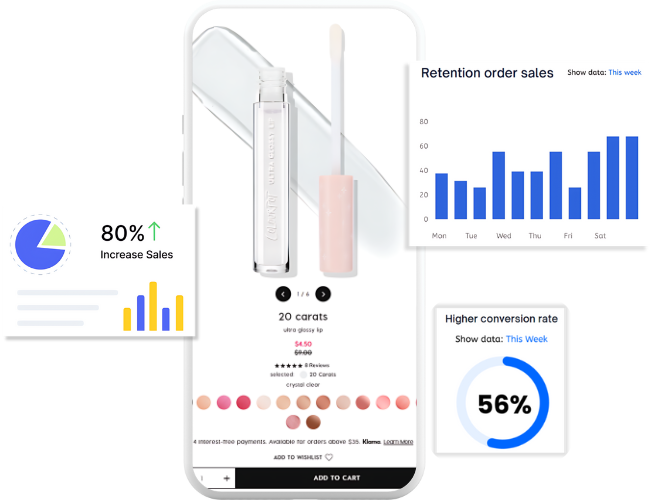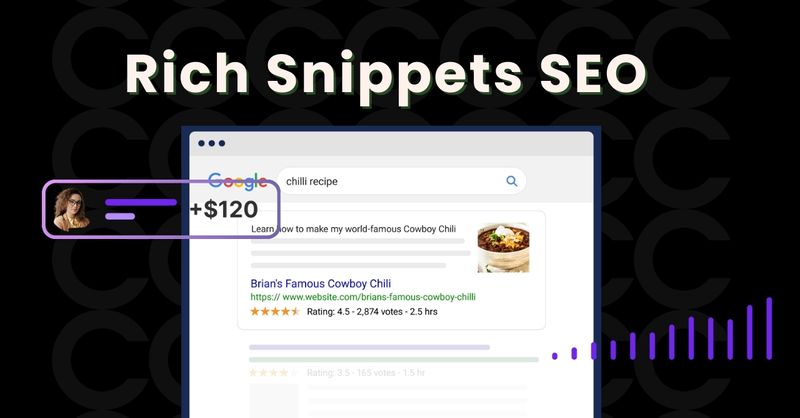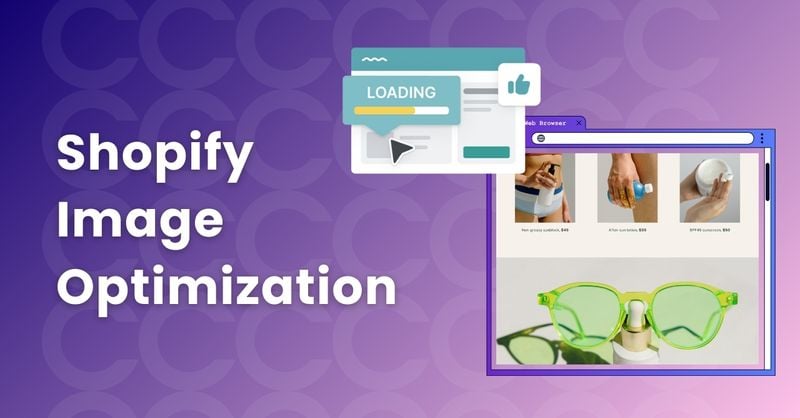In 2025, AI is changing SEO fast. Automation, smart keyword analysis, and better search results make ranking easier—but also harder.
Google’s upcoming Gemini 2.0 AI model, currently in testing, could change SEO rules as we know them. If AI-driven search becomes more dominant, will it be harder to drive traffic to your Shopify store? Some experts predict higher exposure but fewer clicks, meaning traditional SEO strategies may no longer work as before.
For Shopify store owners, this isn’t just a small change—it’s a real risk. If fewer people click on search results, how will you get traffic? How do you make sure your products don’t get buried?
That’s why we made this Shopify SEO checklist. It’s your roadmap to ranking higher, driving real traffic, and boosting sales—so your store stays ahead, no matter how SEO changes.

- 1. Connect Your Google Analytics & Google Search Console accounts
- 2. Submit your sitemap
- 3. Install SEO tools
- 4. Use HTTPS security domains
- 5. Check if your website is indexed
- 6. Determine the core keywords of the website
- 7. Optimize titles and descriptions
- 8. Optimize website URL structure
- 9. Optimize alt tags for images
- 10. Add schema markup
- 11. Create a high-quality blog
- 12. Optimize the internal link structure of the article
- 13. Hire a professional to blog for you
- 14. Improve website loading speed
- 15. Fix 404 pages
- 16. Improve website core web vitals (LCP, FID, CLS)
- 17. ABC backlink building strategy
- 18. Guest post collaboration
- 19. HARO backlinks
- 20. Send a brand mention request
- 21. Optimize your Google Places information
- 22. Multilingual SEO optimization
SEO Basic Tool Checklist for Beginners
1. Connect Your Google Analytics & Google Search Console accounts
Google Analytics shows you where your ecommerce store’s traffic is from. It details which pages are popular, how long visitors stay, and what they do before buying. This data shows what works and where you can improve. Google Analytics can help you make smart choices that boost your store’s conversion rate.
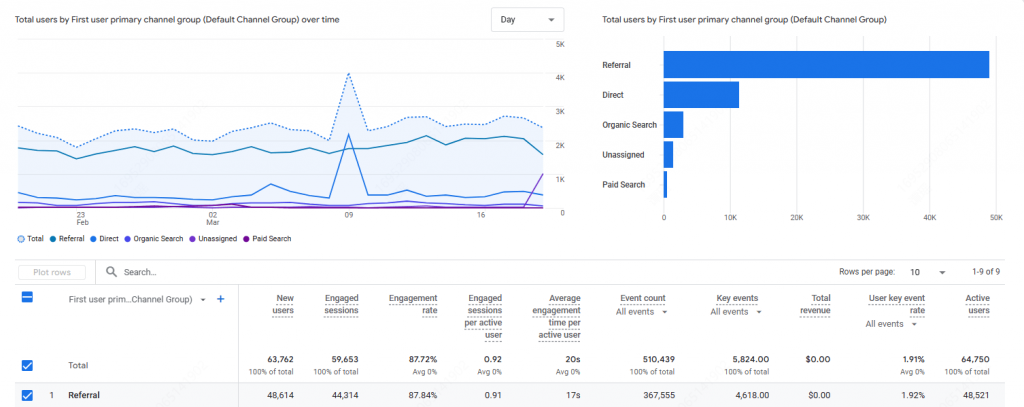
For example, Sarah owns an online Shopify store where she sells handmade jewelry. She uses Google Analytics to track user interaction on her website.
A customer, Dhora, searches for “handmade silver rings” and clicks on Sarah’s store link, and this tool will capture this visit and records details like the traffic source, user location, and device type, among others.
Google Search Console shows how well your site is doing. It shows which keywords bring traffic, how often your pages appear in searches, and any issues that lower visibility.
This tool lets you submit your sitemap. You can also check for indexing issues. It helps Google understand your store’s content better.

As a Shopify owner, you need Google Search Console to improve search rankings and fix technical issues. It alerts you to broken links, mobile usability problems, and security issues that may impact your site’s performance.
2. Submit your sitemap
Ssitemap is essential for SEO. It helps search engine crawlers index all important pages on your e-commerce store.
Be sure to submit your sitemap through Google Search Console. This will enable Google to index your product page correctly. This helps your Shopify site appear in Google search results. This will increase organic traffic to your website.

If you don’t know how to submit your sitemap correctly, please follow Google’s official documentation process.
3. Install SEO tools
Shopify’s SEO tools help your online store. They let you edit meta tags and descriptions. You also get clear URLs and automatic sitemaps. Plus, there are basic schema markups and auto-generated canonical tags.
However, essential SEO functions like advanced schema markups, broken link management, keyword tracking and more require third-party apps.
Some of the best Shopify SEO apps include SEOAnt, Tiny SEO, Booster SEO, Yoast SEO, and SEO Manager. But of course, this is just an exhaustive list. Check out a more comprehensive list of other top Shopify SEO apps. These tools help automate SEO tasks.
If you’re looking for a all-in-one SEO tool, SEOAnt obviously is the most popular choice. It can help you automatically fix broken links, improve page speed, and monitor your competitors’ traffic and rankings.
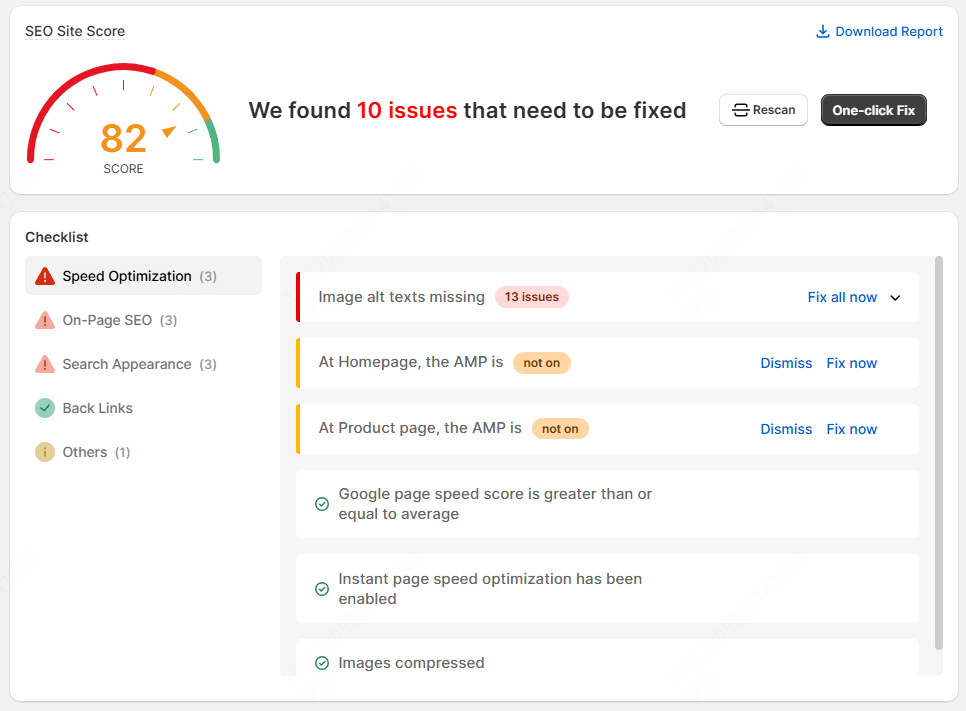
It is worth mentioning that, SEOAnt also integrates ChatGPT so you can generate product titles, descriptions, and rich-content blogs that match your product features with one click.
Suggest Reading: Best 12 Shopify SEO apps for you store
4. Use HTTPS security domains
Imagine this: a user opens your online store, and the screen displays.
“Your connection to this site is not secure. You should not enter any sensitive information on this site (for example, passwords or credit cards) because it could be stolen by attackers.”
That would deter many potential customers who want to buy your product. This is why you need to use an HTTPS security domain.
HTTPS is a ranking factor that suggests a website is trustworthy. It uses encryption protocols like SSL for safe browser-to-server data transmission.
Shopify provides an automatic SSL certificate with domain hosting services. It can keep users’ data safe, secure transactions, and build trust for your e-commerce site. When connecting a third-party custom domain to Shopify, you must verify that your store is HTTPS-enabled. A certificate verification may take up to 48 hours.
5. Check if your website is indexed
Without indexing, your store won’t appear in search results.
To check if your website is indexed, you can simply type your brand in the Google search bar. If you see your website pages in the search results, it means they are indexed.
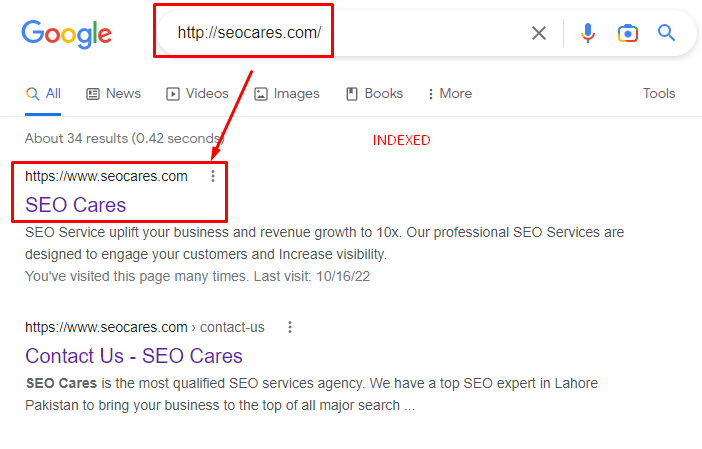
If there are no results, it means your website might not be indexed or there could be indexing issues. You can go to Google Search Console:
- Add and verify your Shopify website
- Use the “URL Inspection” tool to check the indexing status of your pages
- If the page is not indexed, you can click “Request Indexing”
There’s an even easier way. You can use SEOAnt to automatically detects page indexing issues on your website.
On-Page SEO Checklist
Here are a few things to tick off your on-page Shopify SEO checklist:
6. Determine the core keywords of the website
Keyword research involves a strategic implementation of relevant words throughout your website content. It is the foundation of optimizing your Shopify store’s SEO needs.
You should start by identifying the products you sell and how potential customers might search for them.
Use tools like Google Keyword Planner or Ahrefs to find relevant, high-traffic keywords. You can also check what keywords your competitors are targeting, as this can give you valuable insights.
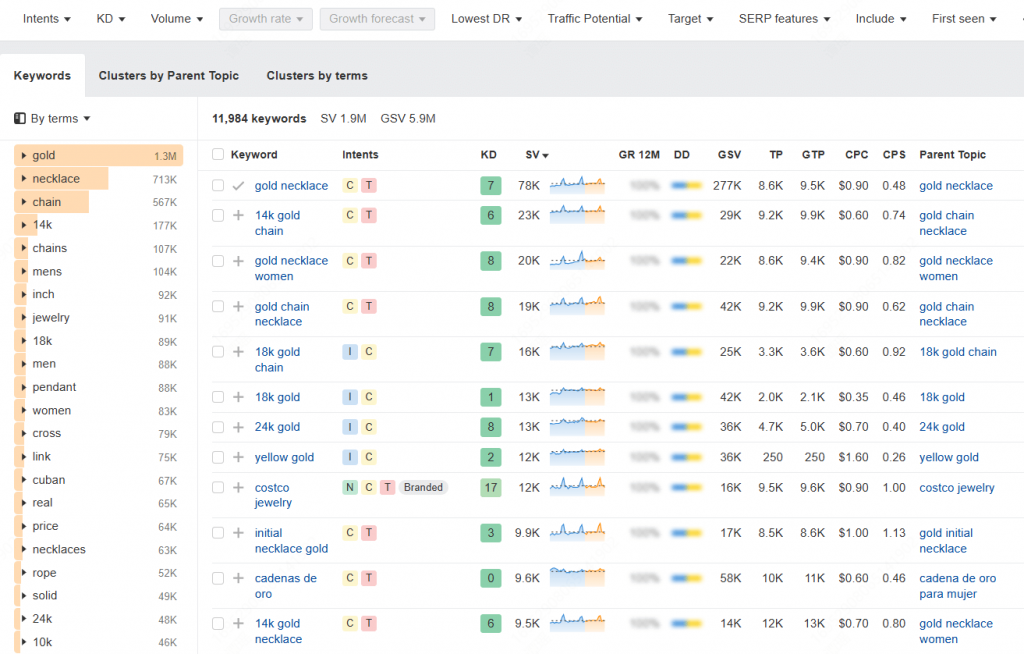
Focus on long-tail keywords specific to your products, as they tend to attract more qualified traffic. Make sure to add these keywords to your product descriptions, page content, and meta tags.
Glossier, a successful beauty brand, used targeted keyword research to drive growth. Instead of competing for broad keywords, they focused on long-tail keywords like “best lightweight moisturizer for sensitive skin.” By creating content around these terms, they improved their Google rankings and attracted qualified traffic.
This strategy led to millions of organic visits, reducing reliance on paid ads. You can learn from this by focusing on long-tail keywords and creating content that answers specific customer queries, boosting traffic and conversions.
7. Optimize titles and descriptions
A 2023 study looked at 300,000 websites. It analyzed their rankings for 10,000 keywords using different data points. Pages with optimized title tags and meta descriptions did better in search results.
To ensure your titles appeal to users and search engines, stick to best practices. First, keep your title short and sweet; 45-65 characters are fine. If it’s too long, it will get truncated by Google.
For example, if you have a lab grown diamond website, you need a clear and SEO- friendly title.
“Buy High-Quality Lab Grown Diamonds | Ethical & Affordable Jewelry”
For meta descriptions, make sure they are fewer than 160 characters. Also, include the primary keyword at the beginning of meta descriptions. For some promotion pages, it’s better to add a strong CTA to encourage users to click.
“Explore our collection of ethically sourced lab-grown diamonds. Affordable, eco-friendly, and stunningly beautiful, perfect for engagement rings and fine jewelry. Shop now!”
- Keywords: “Lab-Grown Diamonds” and “Ethical & Affordable Jewelry” incorporate relevant keywords to help search engines understand the content of the page.
- Clear and Concise: The title is short and to the point, ensuring it displays fully in search results.
- Engaging: The description highlights the benefits of affordability and eco-friendliness, appealing to consumers who value these qualities.
- Call to Action: The description ends with a “Shop now” call to action, encouraging users to take immediate action.
8. Optimize website URL structure
A clear and simple URL structure helps search engines better understand the content of your page and enhances user experience.
Keep it Simple and Clear
URLs should be short and easy to understand. Avoid long, complicated links. For example:
- Before Optimization:
https://www.example.com/products/category1/12345?ref=xyz - After Optimization:
https://www.example.com/lab-grown-diamonds
Use Hyphens to Separate Words
Avoid underscores or spaces. Hyphens (-) are SEO-friendly separators that help search engines understand each word. For example:
- Before Optimization:
https://www.example.com/labgrowndiamonds - After Optimization:
https://www.example.com/lab-grown-diamonds
Use Categories or Subdirectories
For e-commerce websites, using meaningful categories or subdirectories can help search engines understand the relationship between pages. For example:
- Before Optimization:
https://www.example.com/products/12345 - After Optimization:
https://www.example.com/lab-grown-diamonds/engagement-rings
9. Optimize alt tags for images
Google and other search engines cannot ‘see’ images. So, alt tags describe image content. When a webpage fails to load an image, alt text displays the picture’s details.
Adriane owns a small business and runs an online store selling handwoven sweaters. She noticed that her website wasn’t appearing in search results after a year.
Adriane resorted to SEO improvement by optimizing the alt tags on her sweater images. She changed the alt tags to “handmade sweater” across all images. Within a couple of weeks, her website was visible in Google searches.

A good alt text is concise and improves rankings in Google Image Search. Make your content understandable by choosing the correct format and alt text.
10. Add schema markup
Schema Markup helps Google display rich snippets on your page. These include star ratings, reviews, business hours, product availability, and pricing. Some stores display more reviews and star ratings for users at the bottom of their pages. Even if such stores rank lower, they can build trust and increase their click rate.
Schema markups appear differently in search results based on content type. For example, for product listings, they can contain price ($5.99), availability (In Stock), or review ratings (4.5 star rating).
For rich snippets to appear on your website, it must include these information. If your site has a low number of reviews or low ratings, Google is unlikely to display them. Trustoo.io can help by collecting authentic product reviews from Aliexpress and Amazon for display on your website.
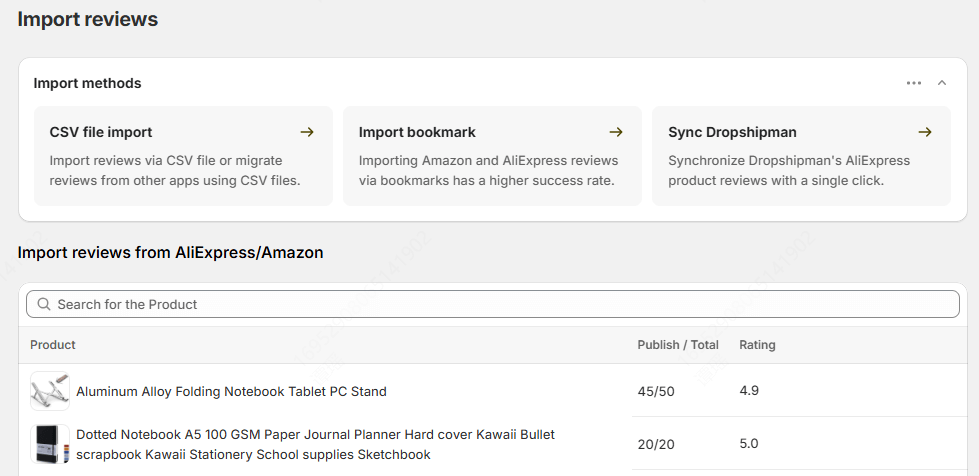
SEOAnt can generate the appropriate Schema markup for your products. It ensures a prominent display of these items in search engines. While this boosts CTR, it also drives high conversions for your brand.
Content Marketing Strategy
11. Create a high-quality blog
A HubSpot article shows that having a blog on your website boosts your indexed pages. This also improves your chances of ranking higher on Google. Blogs are also great for engaging users and driving long-term organic traffic.
Creating high-quality blog content involves adhering to Google E-E-A-T standard. Identify the tartgeted user intent while incorporating relevant keywords that blend naturally with your post. Structure your articles with clear headings and proper formatting.
Understand the audience’s wants, share your knowledge, and earn their trust. Then, offer practical insights that they can use.
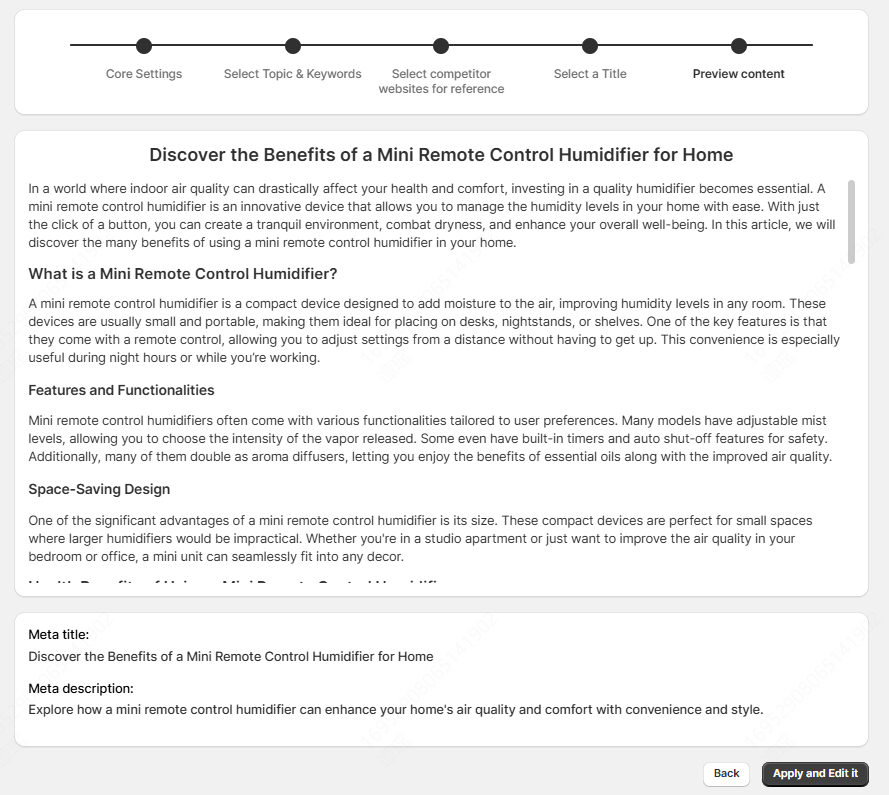
Incorporating these SEO tips into your blog posts calls on potential customers and keeps them hooked on your website.
12. Optimize the internal link structure of the article
Internal links guide visitors to your product page. When implemented well, they improve your engagement rates. You can start by focusing on creating a logical internal linking strategy. Link relevant sections within your article and related content on your website.
Creating a content hierarchy with headers allows for easy in-article links. Proper heading tags, anchor text, and navigation structures ensure an understandable order.
13. Hire a professional to blog for you
Guest blogging helps increase credibility. It also increases external links, attracts more blog traffic, and drives referral traffic.
New York Times Licensing hints at the upside of blog outsourcing:
“It positions you as an expert in the topics related to your business and shows customers you’re up-to-date and informed on the latest trends.”
Always include expert insights and social media links in your blog posts. They build your brand’s credibility and enhance your site’s authority.
You can find professional content experts on LinkedIn or Upwork to write blogs for you.
Technical SEO Checklist
Your Shopify SEO checklist should include a comprehensive technical SEO checklist. Check out some practices to check off this list:
14. Improve website loading speed
If your web page takes time to load, it will frustrate users and might keep them away from your site.
Google sees this negative interaction as a bad user experience. This can hurt your SEO rankings. Large images and unoptimized JavaScript files are factors contributing to slow loading times.
Similarly, mobile optimization is essential. With the widespread use of mobile devices, more and more users are accessing the internet through their phones. Optimizing mobile loading speed can increase your website traffic by at least 20%.
- Compress Images
- Enable Browser Caching
- Reduce HTTP Requests
- Use a Content Delivery Network
- Optimize Server Response Time
- Reduce Redirects
- Reduce the size of HTML, CSS, and JavaScript files
If you’re not familiar with some codes or unsure how to handle technical issues, you might want to consider using a comprehensive SEO speed optimization tool.
SEOAnt can help you automatically detect and fix these issues, and all you need to do is turn on the relevant settings.

Suggested Reading: How to speed up shopify website? 2025 Newest Guide
15. Fix 404 pages
If users land on your page and it shows a 404 page not found error, without a doubt, you’ve already lost a potential group of customers.
What’s even more disheartening is that the trust in your brand will take a hit, both from Google and your website users.
A 404 error indicates that a page no longer exists. This could negatively affect your rankings. Use a 301 redirect signal to inform users that a product page has moved to a new location.
Sometimes, if your website has a large of pages, you don’t know which pages are missing. Don’t worry, SEOAnt can automatically detect your webpages, this powerful tool also allows you bulk redirect missing pages easily.
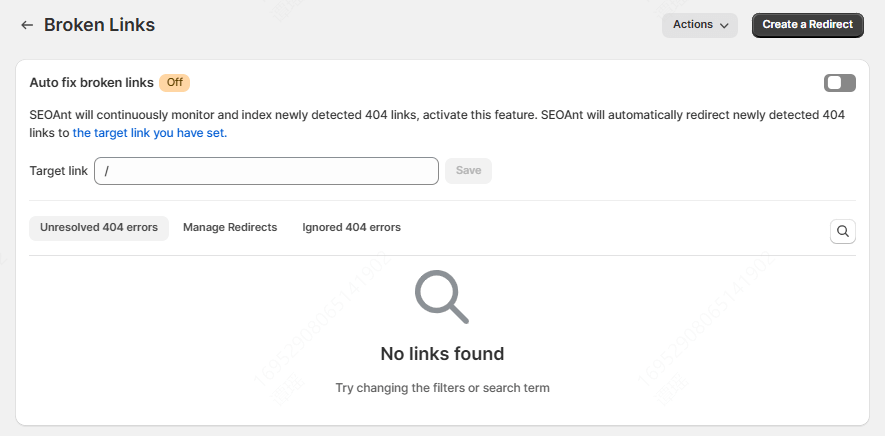
16. Improve website core web vitals (LCP, FID, CLS)
Your website’s core web vitals are crucial for SEO performance and user experience. They are:
- The LCP (Largest Contentful Paint) measures the loading time of the largest visible content on your web page.
- The FID (First Input Delay) evaluates the delay time of a first-time user interaction.
- The CLS (Cumulative Layout Shift) helps check if your webpage’s elements are stable and well-formatted.
You can directly log in to Google PageSpeed Insights to check these metrics. And optimize your website based on the suggestions it provides.
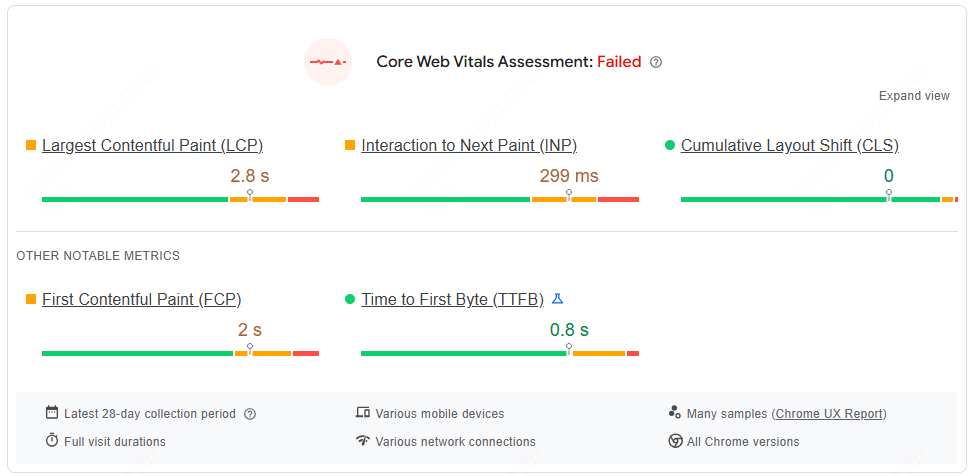
Or you can choose SEOAnt to detect and optimize these metrics. This tool can automatically detect and fix some technical issues on your website, and it can also automatically compress larger images. Most importantly, these features are all free.
Off-Page SEO Checklist
An off-page SEO checklist helps build your website’s value and authority beyond your domain. The following are some of the external sources incorporated into the checklist.
17. ABC backlink building strategy
See backlinks as endorsements from one site to another. A blog post by Content Whale emphasizes:
“Backlinks are essential for SEO strategies because they play a significant role in search engine rankings.”
They are necessary for improving your custom domain authority and search rankings. To help your Shopify website establish cooperation with high-ranking websites, here are the steps to build a strong ABC backlink strategy:
- Build relationships in your industry by reaching out to more partners.
- Do not use out-of-context links.
- Use relevant anchor text.
- Make sure the content quality and spam score meet your requirements.
- Ensure that too many links do not point to the same article within a short period.
If you’re unsure how to acquire more high-quality backlinks, you can consider using SEOAnt. In addition to the speed optimization and high-quality content creation features we’ve mentioned earlier, its backlink exchange feature is also incredibly powerful.
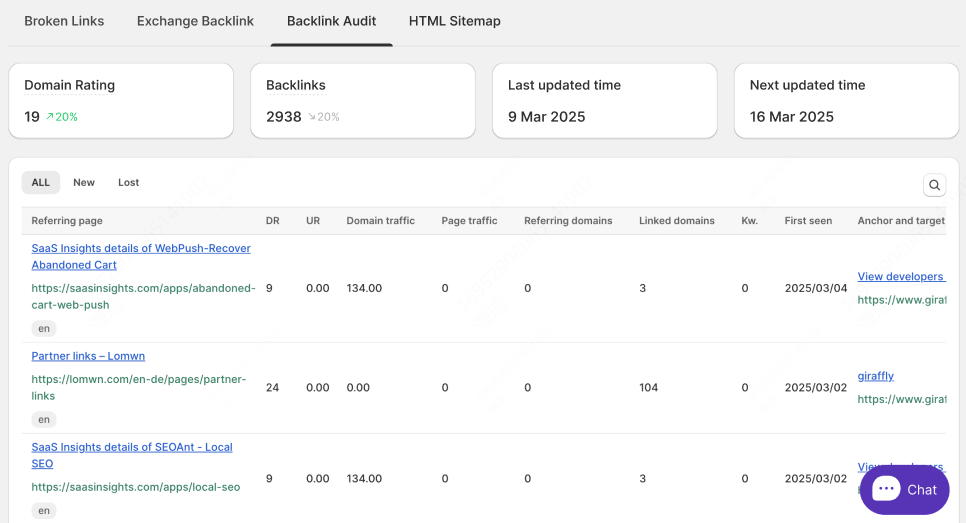
SEOAnt has built a robust link exchange platform for its clients. They mainly use an ABC backlink exchange strategy between three related websites, making your links appear more natural.
All you need to do is add your website category in the settings, and you’ll be added to the list of exchange sites. You can easily view other websites’ domain authority, the number of backlinks, website categories, and their relevance to your site.
This will help you acquire high-quality backlinks more effectively. Then, you can either wait for relevant sites to reach out to you or proactively search for related sites to send link requests.
18. Guest post collaboration
Guest posting lets your Shopify store tap into industry experts. This helps draw in external traffic and boosts your blog’s domain authority. When selecting a guest post opportunity:
- Choose relevant platforms that align with your niche.
- Ensure backlinks point to important product pages.
- Include author bios and social media links to enhance credibility.
You can search on Google for websites with “write for us+ relevant niche” and submit guest posts according to their requirements. Or you can send guest post cooper emails to websites with a similar target audience to yours, seeking collaboration.
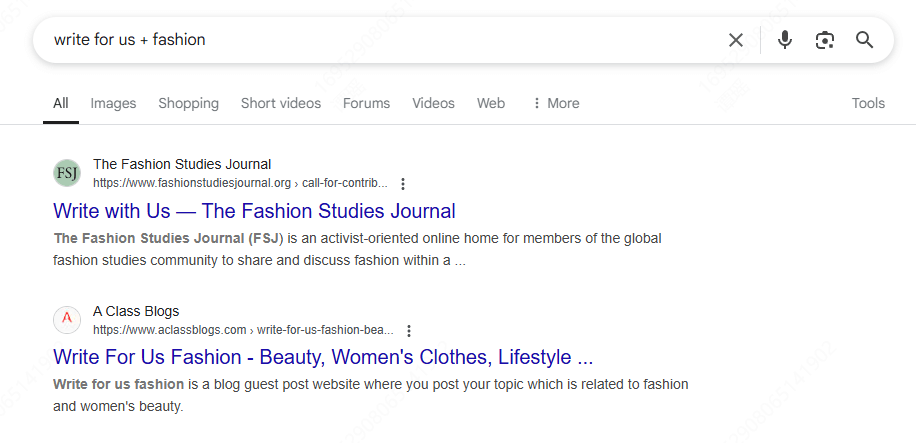
19. HARO backlinks
HARO (Help a Reporter Out) is a platform on which journalists seek to interview industry leaders and experts.
Leveraging such platforms can help you gain backlinks for your Shopify website. The great part? Outreach Monks once revealed that “most HARO services are free to use.”
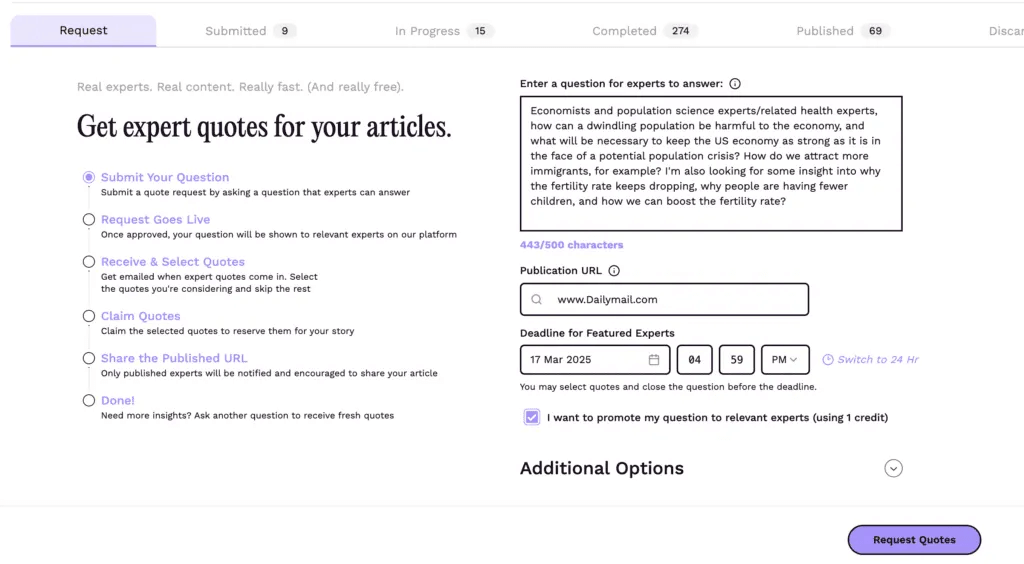
A few tips on how to obtain backlinks through HARO include:
- Ensure the media outlet (backlinker)’s domain rating is high.
- Only respond to relevant queries, but ensure you respond quickly.
- Make your input quantifiable/quotable, and use it as a higher backlink strategy.
20. Send a brand mention request
Brand mentions automatically elevate the quality and visibility of your brand’s backlinks. An example is: “We would be thrilled to be in your ‘Local Business Spotlight’ section. It shows our dedication to community development.”
Unlinked brand mentions limit opportunities to increase your search volume. To ensure this never happens, always do a simple and quick search to find mentions of your online store. A bonus tip is to always keep your Google alert on.

Another scenario is if your brand has been mentioned but the link hasn’t been added. You can send an email requesting them to add your brand’s link, and this situation has a very high success rate.
21. Optimize your Google Places information
Another element of your local SEO checklist is optimizing your Google Places information. Have you ever checked Google for the nearest coffee shop and found reviews on it? That is precisely what a Google Business Profile does for you.
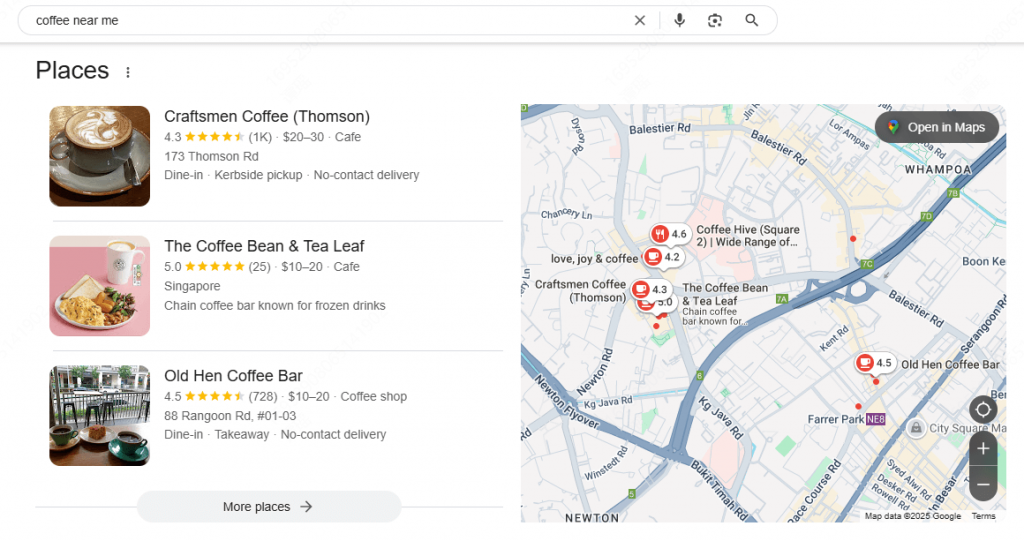
Digitaldot once said, “Customers often choose companies with comprehensive and accessible information.”
Improving your Google Business Profile makes it simpler for customers to find you. Your visibility is enhanced on Google Maps and in local searches. Some key tips for optimizing your Google Place include:
- Ensure your Shopify store’s name, address, and phone number are consistent across all listings.
- Increase and update your business hours frequently.
- Upload high-quality photos of your store and products.
- Encourage customer reviews to boost credibility and ranking.
22. Multilingual SEO optimization
Multilingual SEO is crucial for global expansion. As more users search in different languages, providing multilingual support not only enhances user experience but also significantly improves search engine rankings.
If your brand’s target market is in Brazil, local consumers will definitely search for the products they want in Portuguese. When your website is optimized for multiple languages following good SEO practices, it is highly likely to appear at the top of relevant search results.
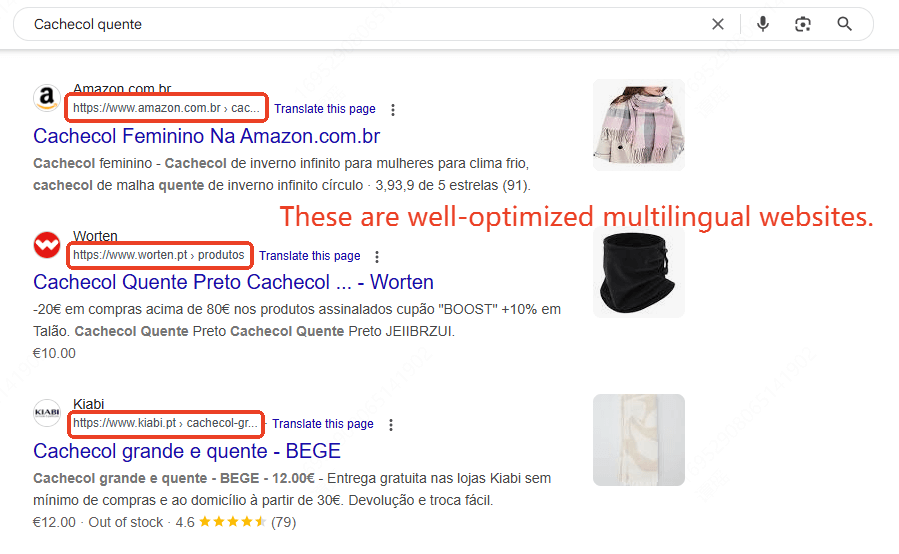
It will bring you more targeted users and higher conversion rates. This is the power of multilingual SEO.
SEOAnt is a powerful SEO tool that integrates with various Shopify multilingual tools, such as Langwill and Weglot, helping your website content automatically adapts to different languages and currencies, attracting customers from around the world.
Also, it provides smart keyword optimization and helps you optimize page content, making your store competitive on a global scale.
By optimizing localized content, adjusting currency displays, and incorporating regional search trends, your business can better serve targeted market and improve your search engine rankings in those areas.
On a Final Note
Compared to short-term advertising spend, SEO is a long-term investment that brings consistent traffic and profits.
Optimizing a Shopify store for SEO requires a structured and continuous approach. You need an SEO checklist to improve your rankings and drive organic traffic to your web page.
It is a never-ending process. Staying ahead requires regular updates, performance monitoring, and strategic improvements.
We know this may be a lot to take in. That’s where we come in. Channelwill provides Shopify sellers with various solutions, from attracting target users and increasing user retention to enhancing the after-sales experience. We help you improve your store’s rankings, boost conversion rates, and increase brand visibility.
